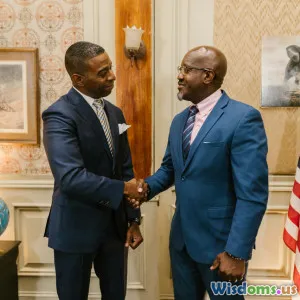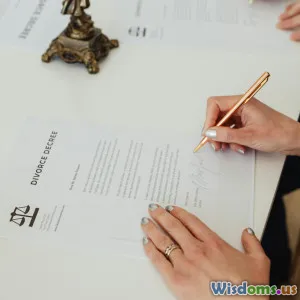
Ten Proven Negotiation Tricks from Top Diplomats
7 min read Discover ten negotiation strategies used by top diplomats to secure remarkable deals through psychology, timing, and communication mastery. (0 Reviews)
Ten Proven Negotiation Tricks from Top Diplomats
Negotiation is an art as much as it is a science, and nowhere is this delicate dance more expertly performed than in the corridors of diplomacy. From brokering peace treaties to managing trade deals, top diplomats have honed strategies that can turn the tide of tension into fruitful agreement. But what hidden techniques underpin these skilled negotiations? In this comprehensive article, we dive into ten proven tricks that have stood the test of time on the global stage. Whether you’re a business professional, a leader, or simply someone curious about negotiation mastery, understanding these tactics can elevate your communication game.
1. Establishing Trust Early
Trust is the bedrock of any negotiation, and diplomats spend considerable effort building it before conversations even begin. This is achieved through transparency about intentions, displaying cultural sensitivity, and honoring commitments.
Example: During the Camp David Accords in 1978, President Jimmy Carter invested significant time in building personal rapport with Egyptian President Anwar Sadat and Israeli Prime Minister Menachem Begin. His candid communication and sincere empathy helped build trust critical to the peace agreement.
Tip: Show genuine interest in the other party’s perspective and avoid premature aggressive stances.
2. Mastering the Art of Active Listening
Top diplomats listen not just to respond, but to understand underlying needs and interests.
Insight: Former U.S. Secretary of State Henry Kissinger famously focused on understanding the motivations beneath Russia’s stated positions during Cold War negotiations, which enabled more effective strategy development.
Active listening includes:
- Paraphrasing to confirm understanding
- Asking open-ended questions
- Observing non-verbal cues
These approaches uncover subtle concessions or priorities that might otherwise be missed.
3. Applying the “Good Cop, Bad Cop” Dynamic
This classic negotiation technique remains effective when used judiciously. In diplomatic contexts, it manifests as representing differing stances equally, allowing the “soft” negotiator to secure concessions after the “hard” negotiator sets a tough baseline.
Historical instance: During the Cuban Missile Crisis, President Kennedy’s administration balanced public hardline rhetoric with back-channel conciliations, which softened Soviet responses.
Caution: This tactic requires calibrated execution to avoid damaging the overall relationship.
4. Utilizing Strategic Pauses and Timing
Silence and well-timed breaks possess immense negotiating power. Diplomats leverage these to convey confidence, prompt concessions, or recalibrate discussions.
Example: The prolonged negotiations that led to the Iran nuclear deal involved carefully timed pauses allowing parties to reconsider stances without pressure.
Moreover, recognizing when the other side is fatigued or pressured can create leverage moments.
5. Focusing on Interests Rather than Positions
The seminal book "Getting to Yes" highlights the importance of distinguishing between positions (what parties say they want) and underlying interests (why they want it). Top diplomats embody this by probing beyond surface demands to address core concerns.
Real-world illustration: The Oslo Accords succeeded by addressing Palestinian aspirations for autonomy rather than merely demands about land.
Advice: Ask “why” more than “what” to reveal opportunities for creative solutions.
6. Employing the Power of Silence
Silence is more than absence of speech; it is a tool to apply psychological pressure. Allowing silence after making an offer or hearing a proposal puts pressure on the other party to fill the void, often prompting favorable concessions.
Insight: Richard Holbrooke, pivotal in the Dayton Agreement, leveraged silence thoughtfully during ride-along/conflicting talks to create space for breakthroughs.
7. Leveraging Reciprocity and Concessions
Generosity can be strategic. By making incremental and sincere concessions, diplomats induce reciprocation, building momentum towards agreement.
Case study: The Good Friday Agreement involved reciprocal disarmament steps by challenging parties, unlocking longstanding impasses.
Maintaining a clear record of reciprocal moves also helps sustain trust.
8. Preparing Thoroughly With In-Depth Research
Information is power. Diplomats meticulously prepare by gathering intelligence about the counterpart’s history, culture, economic pressures, and national priorities.
Example: During WWII, Churchill and Roosevelt used detailed knowledge of Axis weaknesses and Allied public opinion to negotiate strategy terms that aligned mutual strengths.
Preparation enables crafting proposals that appeal directly to counterparts’ incentives.
9. Framing the Narrative
How an issue is presented significantly influences outcomes. Successful diplomats frame negotiations as opportunities for mutual benefit rather than zero-sum conflicts.
Illustration: Nelson Mandela’s framing of South Africa’s transition emphasized reconciliation, enabling peaceful negotiation with former adversaries.
Careful narrative construction helps reshape adversarial mindsets into cooperative engagement.
10. Maintaining Emotional Control and Empathy
Diplomatic negotiations are high-stakes and emotionally charged. Keeping cool, regulating emotional reactions, and expressing empathy for opposing views preserves dialogue quality.
Quote: Former U.N. Secretary-General Kofi Annan emphasized, “The art of diplomacy is to work towards peace through patience, understanding, and respect for differences.”
Empathy demonstrates respect for counterparts and calms tensions, reducing the likelihood of breakdowns.
Conclusion
Diplomatic negotiation is a masterclass in blending psychological insight, cultural awareness, strategic timing, and emotional intelligence. The ten techniques outlined—ranging from building trust early to maintaining emotional control—have been battle-tested through history’s most challenging talks. By adopting and adapting these proven methods, anyone can transform negotiations into opportunities for durable, meaningful agreements. Whether you are brokering deals in the boardroom or mediating conflicts in daily life, the lessons from top diplomats offer a roadmap to negotiation excellence.
Embark on your next negotiation armed with these strategies to influence outcomes positively and build lasting partnerships.
Rate the Post
User Reviews
Popular Posts




















